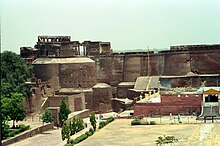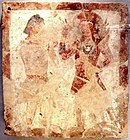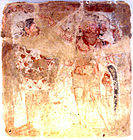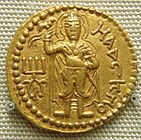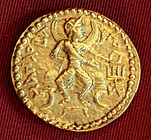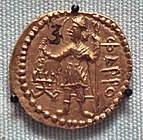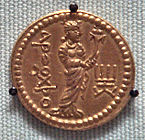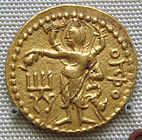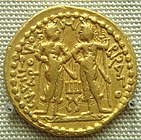::Huna origin of Gurjara Clans::
Dr. Sushil Bhati
Many renowned historian like A. M. T. Jackson, Buhler, Hornle, V. A. Smith and William crook Consider the Gurjaras to be of Huna stock. The way in which inscriptions and literature records frequently bracket Gurjaras with the Hunas suggests that the two races were closely connected. There are evidences that the Gurjaras were originally a horde of pastoral nomads from the Central Asia whose many clans have Huna origin.
Numismatic Evidences- Coins issued by Hunas and Gurjaras have remarkable similarity. In a way coins issued by Gurjaras are continuation of Huna coinage. Coins issued by Hunas and Gurjaras are characterized by motif of ‘Iranian fire altar with attendants’ and are copies of coins issued by Iranian emperors of Sassanian dyanasty. The inferences of Huna’s connection with Gurjaras is strongly supported by numismatic evidences. V. A. Smith has presented these evidences in his paper “The Gurjaras of Rajputana and Kannauj’ in these words, “The barbaric chieftains who led the greedy hordes known by the generic name of Huna to the plunder of the rich Indian plains did not trouble to invent artistic coin dies, and were content to issue rude imitations of the coinage of the various countries subdued. After the defeat of the Persian king Firoz in 484 A.D., the Huns chiefly used degraded copies of the Sassanian coinage, and in India emitted extensive series of coins obviously modelled on the Sassanian type, and consequently classified by numismatists as Indo-Sassanian. Many varieties of this Indo Sassanian coinage, especially those bearing the names of Toramana and Mihiragula or Mihirakula, can be recognized with certainty as Hun issues.
The long series of Gadhiya or Gadhaiya coins in base silver and copper or bronze, although usually without legends or dates, may be assigned now with equal confidence to the Gurjaras. These coins, which present the Sassanian type in its utmost degradation, are found most abundantly in the countries occupied by the Gurjara clans, which quickly developed into Hindu castes, and they evidently formed the ordinary currency of the Gurjara kingdoms in Western India and Rajputana for centuries. A Jain writer relates a legend which expressly connects the origin of the Gadhiya coinage with Bhilmal, the Gurjara capital.
One coin, not of the Gadhiya type, bearing the name of Vyaghramukha has been published. That name being of rare occurrence, the piece, which is of rude fabric and comes from a locality where it was associated with White Hun coins, is almost certainly a coin of Vyaghramukha, the Chapa Raja of Bhilmal in 528 A.D. The Chapas were a branch of the Gurjaras. The coin closely resembles in fabric the undoubted Hun issues, and when I published it I believed it to have been struck by a White Hun chief, but now perceive that it is Gurjara.
The Gurjara lineage of King Mihira Bhoja being an established fact, his Adi-vardlia coins, which imitate the Sassanian coinage in another fashion, must also be classed among the Gurjara issues.”
Presence of Varaha as a motif on coins of Gurjara- Pratiharas also support the theory of Huna origion of Gurjaras. Varaha was tribal deity of Hunas which later evolved into or identified with the incarnation of Vishnu.
Thus, we see that the numismatic connection between the Hunas and the Gurjaras is extremely close.
Common family name of Hunas and the name of Gurjara king Alkhana- According to E. Rtveladze, the name of royal family of Hunas was Alkhon. Humbach proposes that the reading of this name should be “Alkhan”. Alkhan was also the name of a Gujar king of Punjab Gujrat at the close of ninth century which find mention in Kalhan' Rajtarangini.
Mihira as common title among Hunas and Gurjaras- Kosmas Indikopleustes has mentioned a Huna king Gollas in his book Christian topography. The king is identified as MihirGula or Mihirkula by Historians Mihira was probably the title of MihirGula and his actual name was the Gula. Mihira is also the title/name of most famous Gurjara emperor Bhoja (836-885 A D) of Kannauj. It is still a title of honour amongst Ajmer Gurjaras.
Mehrauli- Mehrauli, one of the seven ancient cities that make up the present state of Delhi, was earlier known as Mihirawali means abode of Mihiras or row of houses of Mihiras. According to Campbell Mihira is just the another name of Huna tribe. It was probably founded by Hunas during the reign of Emperor Mihirkula as he has tradition of founding the new cities. According to kalhana’s Rajtarangani Mihirkula also founded the city named Mihirpur in Kashmir. Mehrauli area is still inhabited by four villages of Bidhuri clan of Gurjaras which do not intermarry with their Huna clan as they consider themselves as one and the same. Mehrauli area also have twelve villages of Tomara/ Tanwar Gurjaras which also have Huna origin as per the testimony of pehowa inscription and are considered to be the descendent of Javula Tormana, the celebrated Huna Chief and father of Emperor Mihirkula..
Common Varaha worship among Hunas and Gurjaras- Prevalence of Varaha worship and Varaha as title among Pratiharas also support the theory of Huna origin of Pratiharas. According to H Goetz, Varaha was tribal diety of Hunas which later evolved into or identified with the incarnation of Vishnu. Hunas worshipped the Varaha as Varahamihir. Tormana,s inscription of first year of his rule is found on the Varaha statue from Eran in Central India. Later Gurjara Pratiharas not only promoted the Varaha Worship but also adopted Varaha as their general title. Contemporary Arab scholars call Pratihara rulers Baura (Varaha). According to Goetz most of the Varaha temples were constructed during Huna-Gurjara Reign.
Clan Study of Modern Gujaras also suggest their Huna origion-
Huna has been an important Clan of Gurjara from remote past. Mansukh Gurjar, the friend of Puranic King Nal belonged to Huna clan of Gurjaras There are atleast twelve villages of Huna Gurjaras in Meerut and Hapur districts. There are four Huna Gurjara Villages in laksar tehsil of Haridwar district of Uttrakhand state and around seven villages in Alwar District of Rajasthan. Huna Gurjaras are most numerous in Bundi and Kota areas of Rajasthan that was once known as Huna Pradesh.
Marid is a sub-clan of Huna clan that does not intermarry with Huna clan because they consider themselves one and the same. Manohara is prominent village of Marid Hunas in Sahranpur district.
Bidhuri is also a sub-clan of Huna Gurjaras, which have sizeable number in Delhi and Rajasthan. Mehrauli area is still inhabited by four villages of Bidhuri clan of Gurjaras which do not intermarry with the Huna clan as they consider themselves as one and the same.
Paramara/Panwar clan also seems to be of Huna stock. According to one legend recorded by Col. Todd Shiva temple of Badoli in Kota district of Rajasthan was built by Huna Raj of Panwar dynasty. The legend supports the Huna origin of Panwars. In Pakistan the Hun/Hon Tribe of Potohar district Claims its descent from Jugdeo Panwar which proves the oneness of Panwars with the Hunas. Furthur this relation of oneness is proved by the fact that the Bidhuris sub clan of Huna Gurajaras also claim their descent from Jagdeo Panwar. Khoobad sub-clan of Panwar Gurjaras have 84 villages in Sahranpur district. They also claim their descent from the Jagdeo Panwar. The khoobar have a remarkable phonetic similarity with the name of Kabar tribe of Hungary which claim a descent from Attila’s Huns. According to the bhats of Khoobad Panwars they have migrated to Saharanpur from Dhar of Malwa. Malwa remained the strong hold of Hunas for a long time and after their defeat by Yashodharman they dispersed in all the direction.The legend of Jugdeo Panwar as their ancestor is of special importance among many Gurjar clans as many clan including Huna consider him their ancestor. Historicity of this legendary hero is proved by Jainad inscription from former Hyderabad state according to which Jagaddeva Paramara conquered the Arbuda region in 1093 A D. Early History of Gurjaras including Panwaras is connected with Arbuda/Abu region is proven fact.
Lohmor- Like Hon/ Hun of Punjab, Bidhuris of Delhi and Khoobar Panwaras of Saharanpur Lohmor clan of Gujaras also claim its origin from Jugdeo Panwar.Thus like three others it also have the Huna origin. The transliteration of Lohmor is Iron Peacock. Peacock was the important motif found on Huna coins.
Mundan/Mandar is a sub-clan of Panwar, thus it have a Huna origin. Bali near Baghpat is a important village of Mundans.
The Hathwal clan of Gurjaras is found in Saharanpur and Haryana The clan name seems to be the Indian version of Haftal/ Hephtelite, the another name of white Hunas.
Mori- Gwalior and Chittor grew in political importance during the Huna period. Probably forts at both the places were constructed by Mihirkula. Mori clan ruled from fort of Chittor before the Bapa Rawal took the fort in his Command. Probably Moris ruled at Chittor on behalf of their Huna Emperor. The Mori Gujaras are still found in the nearby area of Chittor. Mori means pertaining to Mor i.e. Peacock. Peacock is an important motif on Huna coinage as already been said.
Chapa or Chaprana, Chavda and Chapotkat Chapa or Chaprana, Chavda and Chapotkat all are the variation of the same clan of Gurjaras. The word Chapa means arch and the word Chapotkat means the best archer. Hunas were supposed to be the best cavaliers and archers of the contemporary world. King Vyaghramukha who ruled the Gurjardesha (Modern Rajasthan) from Bhinmal in seventh century belonged to the Chap clan of the Gurjaras. His coin resembled the Huna coins so much that it was termed as Huna coin of Vyagrmukha by V. A. Smith. Chapranas and Huna Gurjaras are known as Pag-palta brother in Chambal division of Madhya Pradesh. Vanraj Chavda who founded the city of Anhilvada was the Panwar and Panwar are Gujaras of Huna origin, thus Chap, Chaprana, Chavda and Chapotkat are also of Huna origin.
Peelwan in Hindi mean the elephant owner. After their victory over Gupta Empire Huna organized a vast Elephantry for the war purpose which was feared much by the other power. Greek writer casmos indikoplestes tells in his book ‘The Christian Topography’ that Hunas King moved along with a large cavalary and atleast 2000 elephants. Some Gujara clans might have connection with this Huna attribute, Peelwan is one of them.
Pathaa or Pataya is a sub clan of Peelwan. Patha of Akhoda Kalan calls them Pratihara. Infact when a word of an Apbhransa or a Prakrit or an alien language was adopted in Sanskrit extra r (र) were added sometimes to it to suit the phonetics of the new language, e.g. Gujara becomes with one extra r (र) to Gurjara, Munda becomes Murunda and Jat becomes Jarta. It is possible that original word for Pratihara might be or like Pathaa which on addition of two r (र) changed to Prathar/Pratihar in Sanskrit. Antwada, Bhatoda etc in Muzaffanagar district are the important Village of this Gujara clan.
Gajgahi- Like Peelwan clan Gajgahi clan might have connection with the Huna Elephantary.
Tomara or Tanwar - There is a proverb in Hindi “Dilli tanwaro ki”which means that Delhi belongs to Tanwaras.AS already mentioned Mehrauli area of Delhi still have twelve villages of Tomara/ Tanwar Gujaras which also have Huna origin as per the testimony of pehowa inscription and are considered to be the descendent of Javula Tormana, the celebrated Huna Chief. Tomara/Tanwar Chief Anangpal Constructed the Lalkot fort at Mehrauli and Shifted his Capital from kannauj to Lalkot. There is Gujara village Anangpur named after this king not far from Mehrauli in Faridabad district. The first inscription of Tanwara clan is found from pehowa in Karnal. There is very large Gujara Tanwara Village Kyodaka near Pehowa. The place of earliest History of Tanwara clan, Pehoea and Delhi, are still inhabited by Gujara Tanwaras.
Padiyar or Pratihar- It is interesting to note that there is still the Gujaras of Padhiyar clan nearby the Ujjain, the original seat of imperial Pratiharas of Kannauj. It is another evidence of imperial Pratiharas of Kannauj being a Gujara Clan. According to A. Cunningham and Rudolph Hoernle Pratiharas were Tomaras. Hornle said that the Anangpal Tomara Who built The Lalkot fort at Mehrauli was Scion of the imperial Pratihara family of Kannauj. As Tomaras are descendents of Huna King Tormana, Pratiharas were also of Huna origin. As I have already said earlier prevalence of Varaha worship and Varaha as title among Pratiharas also support the theory of Huna origin of Pratiharas. Varaha was tribal diety of Hunas that later evolved into or was identified with the incarnation of Vishnu. Numismatic evidences also suggest Huna connection of Pratiharas. Pratiharas imitated the sassanid type coin of Hunas.
Chalukyas or Solanki- Accoding to Hornle a section of Hunas moved to south India after their defeat in a battle with Yashodharman in Malwa. This section under the leadership of Chalukya Clan established the kingdom Of Vatapi in the latter half of the sixth century A. D. Later another branch from North established a kingdom named Gurjar or Gurjara mandala or Gurjartta in modern Gujrat. Solanki clan is still found among Dore Gujaras of Maharastra and among Gurjaras of Bareilly district of Uttar Pradesh.
Khari- Kharis clan of Gujaras seems to have Huna ancestory. Their family bards claim that Khari clan has migrated to Delhi from Sialkot, the Capital of Hunas. In Rajasthan Gujaras have two sub-division namely Lor and Khari and there Huna clan belongs to Khari Sub-division of Gurjaras.
Hara or Hada Chauhan- This clan of Hadoti region of Rajasthan seems to belong to Hara- Huna section of Hunas. This region of Rajasthan was once known as Huna Pradesha due to predominance of Hara-Hunas. there is still a large population of Huna Clan of Gujaras in mainly the kota and Bundi districts of Hadoti region. Even Bundi City has some Huna Gujara Families. Hadoti region is still inhabited by Chauhan Gurjaras of Hara Huna origion.
Guhilot- Guhilot clan originated from Maitrakas Of Valabhi. Term Maitrak means pertaining to Mithra or Mihira. Mihira was just another name of Hunas. Mihir is a title used by Huna Emperor Mihir Gula and Gurjara Emperor Mihir Bhoj. Mihir is still title of honour among Ajmer Gujaras. According to D R Bhandarkar Guhilots were originally Mihiras/Mers of Huna-Gurjara group.51 Chittorgarh region once the seat of power of Guhilots still has few Huna Gujara villages.
The Gujars are a well-known and powerful caste, numerous in Rajasthan, parts of the Panjab, the northern districts of the Uttar Pradesh, and Central India. Gujaras are primarily a pastoral people, with a strong tendency to a life of rapine like historical Hunas but in modern times they are largely devoted to agriculture. In recent past Gujaras followed Polyandry like Hunas. Thus peculiarities of the Modern Gujars also indicate that their ancestors were members of a pastoral horde.
Bibliography
1. A. M. T. Jackson, Bhinmal, Bombay Gazetteers, Vol. IX
2. A. R. Rudolf Hornle, “The Gurjara clans, some problems of ancient Indian History” No. III. JRAS, 1905, pp 1-32
3. V. A. Smith, The Gurjaras of Rajputana and Kanauj, Journal of the Royal Asiatic Society of Great Britain and Ireland, (Jan., 1909), pp.53-75
4. Tod, Annals and antiquities of Rajasthan, Edit. William Crooke, Vol. I, Introduction
5. D R Bhandarkar, Gurjaras, J B B R A S, Vol. 21, 1903
6. B.N. Puri, History of the Gurjara Pratiharas, Bombay, 1957
7. J M Campbell, ‘The Gujar’ Gazeteer of Bombay Presidency, Vol. IX, Part II, 1896
8. K B Pathak, Commemorative Essay, New light on Gupta era and Mihirkula, P-25
http://www.archive.org/…/commemorativeess00bhanuoft_djvu.txt
9. V A Smith, The Oford History of India, IV Edition, Delhi, 1990
10. P C Bagchi, India and Central Asia, Calcutta, 1965
11. Dr. G.V. Divekar: An Ethimological Estimate of the Sakas, Bombay, 1980.
12. Bongard Levin, From Scythia to India, Budapest, 1981.
13. C.T. Metclfe: The Rajput Tribes, Vol. I., II. London, 1822.
14. Romila Thapar, A History of India, Vol. I., U.K. 1966.
15. D.R. Bhandarkar,“Foreign element in the Hindu populations”, IA Vol.40, 1911
16. Dr. S.S. Shashi, The Shepherds of India, Sundeep Prakashan, Delhi, 1978.
17. Romesh Chunder Dutt, A History of Civilization in Ancient India, Vol. II., Vishal Publishers, Delhi, 1972
18. Atreyi Biswas, The Political History of the Hunas in India, Munshiram Manoharlal Publishers, Delhi, 1973.
19. Upendra Thakur, The Hunas in India, Varanasi, 1967, Chowkhamba Sanskrit Series Office
20. Aurel Stein, Ázsia halott szívében (In Asia’s dead heart), Budapest, 1985, Helikon
21. Aurel Stein, White Huns and kindred tribes in the history of the north west frontier, IA XXXIV, 1905
22. A. Cunningham, Ancient Geography of India, London, 1870
23. A.Cunningham, Mediaeval Indian coins, London, 1894
24. J F Fleet, Corpus Inscriptionum Indicarum, London, 1888
25. J F Fleet, Coins and history of Toramana, IA, 1889
26. R. Ghirsman, Les Chionites-Hephtalites, Cairo, 1948
27. J J Modi, Early history of the Hunas, JBBRAS, 1917
28. Sten Konow, Note of Toramana, IHQ, 1936, XII
29. W M McGovern, The Early Empire of Central Asia, Chapehill, 1939
30. Baden-Powell, Notes on the Rajput clans, JRAS, 1899
31. D C Sircar, Epigraphia Indica, 1963, Calcutta
32. D C Sircar, Select Inscriptions, 1942, Calcutta
33. R S Kushawa, A Glimpse of Bharatiya History, 2003, Delhi
34. R S Tripathi, History of Kannauj
35. M J Mohl, Firdausi, 1878, Paris.
36. R. Ghirshman, Les Chionites-Hephthalites, Cairo, 1948.
37. R. Göbl, Dokumente zur Geschichte der Iranischen Hunnen in Baktrien und Indien, Wiesbaden, 1967, Vol. III.
38. Frantz Grenet,“Regional Interaction in Central Asia and Northwest India in the Kidarite and Hephthalite periods”, Proceedings of the British Academy, 2002, pp.203-24.
39. S. Kuwayama, “The Turki-Shāhis and relevant Brahmanical sculptures in Afghanistan,” East and West, 1976, pp. 375-407.
40. B. A. Litvinsky, “The Hephthalite Empire” in B. A. Litvinsky et al., eds., History of the Civilizations of Central Asia, III: The crossroads of civilizations, A.D. 250-750, Paris, 1996, pp. 135-62
41. A. Miller, Accounts of the Western Nations in the history of the Northern Chou dynasty, Berkeley, 1959, esp. pp. 11-12.
42. Nicholas Sims-Williams, “Bactrian documents from Northern Afghanistan: the decipherment of Bactrian”, London, SOAS, 1997
43. D. C. Sircar, “Three early medieval inscriptions: Kabul inscription of Shāhi Khingāla,” Epigraphia Indica 35, 1963, pp. 44-47.
44. H Goetz, The Early Wooden Temple of Chamba: Rejoinder, Artbus Asiac, Vol 19, pp162
http://www.jstor.org/discover/10.2307/3248719…
45. H Goetz, Studies in the history and art of Kashmir and the Indian Himalaya
http://books.google.co.in/books…
46. Sung-Yun: “Voyage de Song-yun dans l’Udyana et la Gandhara” par. E.Chavannes, BEFEO, vol. III. 1895.
47. Xuan Zang, Si-yu-ki, tr. by S.Beal, 2 vols. London, 1884, reprint Delhi, 1964.
48. Vishnu Purana, ed. by Jivananda Vidyasagara, Calcutta, 1882.
49. Kalidasa, Raghuvamsa, tr. by Nilmani Mukhopadyaya, Calcutta, 1880.
50. Kalhana, Rajatarangini, tr. by M.A. Stein, 2 vols. London, 1900.
51. Udyotana Suri, Kuvalayamala, tr. by A.N. Upadhya, Singhi Jain Series No. 45., Bombay, 1959.
52. Bana, Harshacarita, tr. by C.B. Cowell and F.W. Thomas, London, 1897.
53. Aitareya Brahmana, tr. by Haug, 2 vols. Bombay, 1863.
54. Procopius, De Bello Persico, tr. by H.B.Dewing, New York,1914-40, 7 vols
55. Kosmas Indikopleustes, Christian Topography, tr. by J.W. Mc’Crindle, London, 1897.








